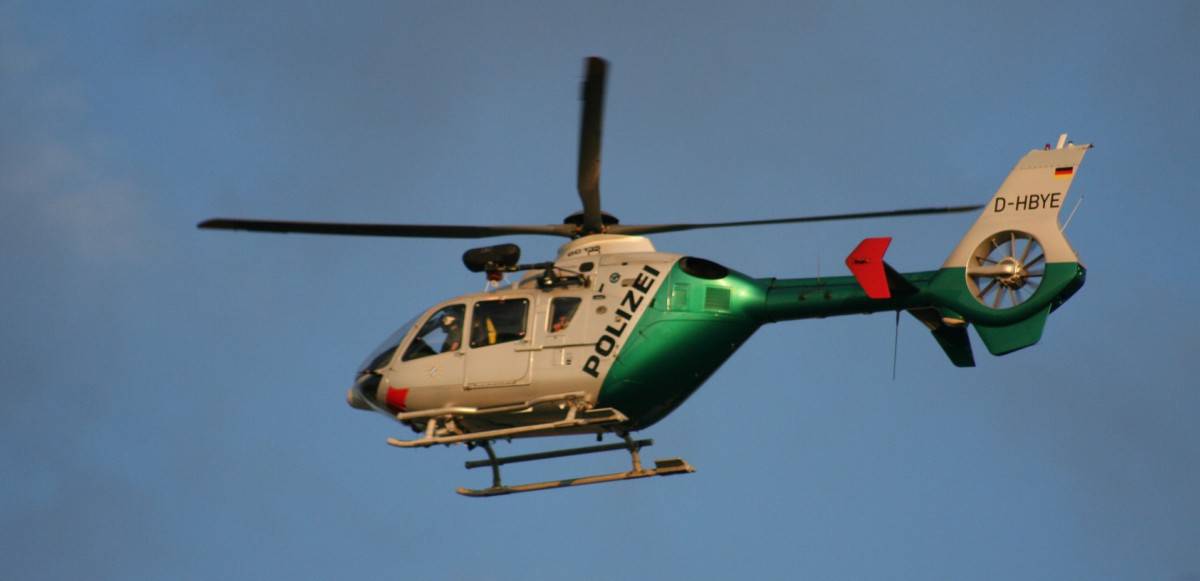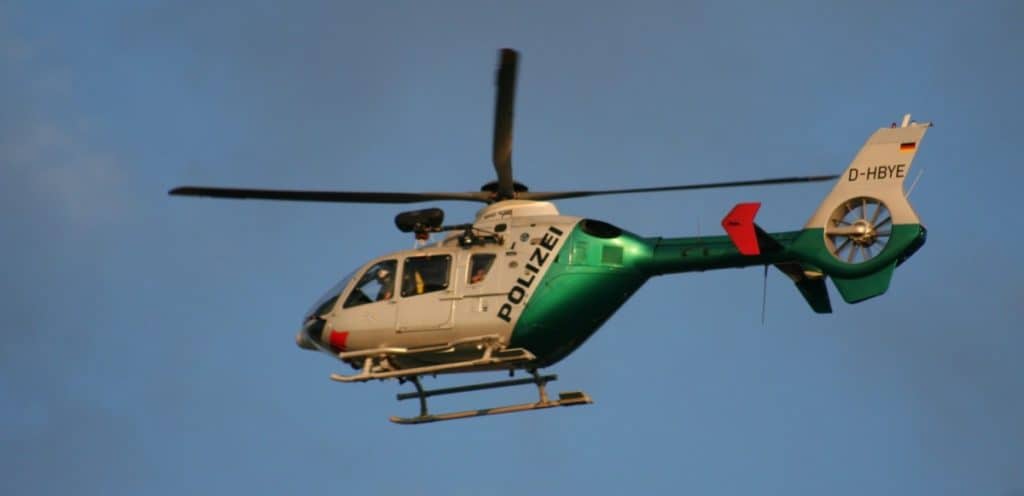
Police helicopters are seen flying around every major city. The type of helicopter used varies as do their capabilities. No matter if you are interested in police helicopters for pure interest or to give yourself an edge this article gives you all the answers to the most common questions regarding police helicopters!
Why Do Police Helicopters Circle Over My House?
Police helicopters may be flying circles over your house as an incident they wish to observe is taking place in your general area. By flying in circles, the crew can view a large area easily with their camera. Your property may not be of interest, just in the vicinity.
Criminal activity, searching for missing persons, video evidence gathering, or providing overwatch for police operations are just some of the most common reasons why a police helicopter may be circling over your property.
Many buildings can be seen from just 500-1,000 feet above the ground, so even though it may seem like the police are circling your home, they most likely will be looking at a building several streets away, especially if you don’t give them a reason.
How Long Can a Police Helicopter Fly For?
Generally, most police helicopters can fly for around 2-3 hours depending on the model. Most helicopters can refuel at any nearby airport and be back in the area in around 20-30 minutes and some helicopters based in remote areas can have an auxiliary fuel tank to increase the time up to 5 hours.
The size, number of engines, size of the fuel tank, and how much equipment the helicopter is fitted with will dictate how long it can fly.
The majority of police helicopters will fly for around 2 hours on most missions. If a large event is occurring the helicopter can be flown at a speed to maximize its fuel efficiency and keep it in the air for longer.
Some police helicopters can be fitted with an auxiliary fuel tank that can almost double its flight time to 4-5 hours if required, but this is not a regular occurrence.
If a police helicopter has been out flying for a while and then is called upon to assist with an incident it may need to head into the nearest airport to refuel before getting on the scene. Depending on how far away the nearest fuel source is this can be as short as 15 minutes or up to an hour.
How Long Can a Police Helicopter Hover For?
Most police helicopters will be able to hover on the scene for around 2 hours. Hovering over a city requires the most power which increases the fuel burn rate. High altitude, high humidity, high temperature, and the weight of the helicopter all reduce the amount of time the helicopter can hover.
Most police helicopters will be seen to fly in circles or orbits when over a scene. Hovering requires the most amount of power in a helicopter and uses far more fuel than flying in a slow orbit.
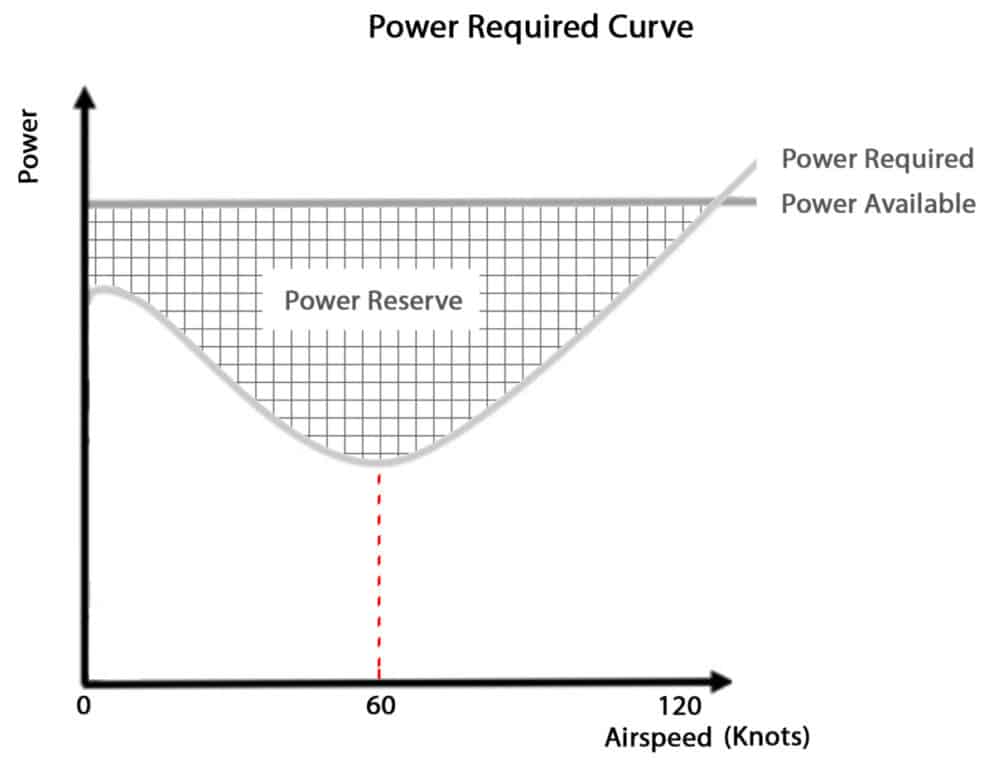
Here you can see the power required to sit in a hover at 0 airspeed requires far more power than flying slow orbits at 60 knots. By flying in orbits police can extend their duration over a scene.
When police helicopters do come into a hover it is usually because the object they wish to observe may be obscured from view when doing an orbit. By keeping the helicopter in a stationary hover, the camera operator can keep the scene in view at all times.
This could be especially important when providing overwatch when a S.W.A.T. team is about to breach a building with known resistance on the inside.
How Fast Can A Police Helicopter Fly?
Generally, most police helicopters can fly between 80-130kts/90-150mph/150-240kph. At top speed, flying in a straight line, a police helicopter can reach 20 miles away in as little as 8 minutes. As roads curve, helicopters can fly straight, allowing them to keep up with the fastest cars & motorcycles.
A small police helicopter like a Bell 206 Jet Ranger or Robinson R44 may only be able to cruise around 100 knots, but a large, powerful helicopter like a Leonardo AW139 or Airbus H155 can be up to around 150kts. Flying in a straight line allows these helicopters to cover the ground rapidly.
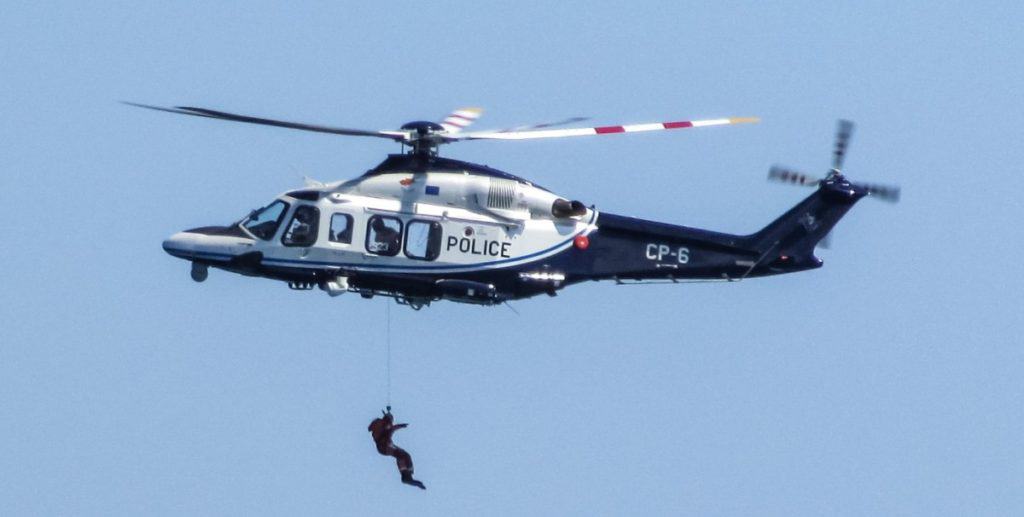
Even if a police helicopter is slower than a speeding motorist they are able to keep an eye on the subject using the powerful zoom on their camera and not having any speed restrictions like other traffic or bends in a road. By flying in a straight line the helicopter is able to ‘Cut the Corners’ and direct the ground units via the radio.
| Helicopter Airspeed | Miles Per Minute | Time To Fly 10 Miles | Time To Fly 30 Miles |
|---|---|---|---|
| 90 mph | 1.5 | 7 minutes | 20 minutes |
| 100 mph | 1.7 | 6 minutes | 18 minutes |
| 110 mph | 1.8 | 5.5 minutes | 17 minutes |
| 130 mph | 2.2 | 4.5 minutes | 14 minutes |
| 150 mph | 2.5 | 4 minutes | 12 minutes |
What Can Police Helicopters See?
Police helicopters can see during the day using an HD color camera and an infrared camera at night. They are not able to look through walls, roofs, or dense foliage but can see through windows during the day. Objects of differing temperatures are easily seen with the infrared camera, especially at night.
Mounted to the nose of every police helicopter is a controllable turret that houses an HD color video camera, an HD color stills camera, and an Infra-Red thermal imaging camera. Mounted to these cameras are powerful zoom lenses (up to 120x) that can allow the camera operator to see objects very clearly from several miles away.
The camera is able to transmit its pictures to ground units and police headquarters to allow real-time observations by any officer required, although its control of what it sees is only maintained by the camera operator on board the helicopter.
For far more details on exactly what a police helicopter can and cannot see I highly recommend you read this:
Police Helicopters – They Can See In Your House! Or Can They?
How Far Can a Police Helicopter Camera See?
Most police helicopter cameras can see up to 3-5 miles from 1000ft above the ground. Large objects can be easily seen at far distances whereas a car registration plate would need the helicopter almost directly overhead. The closer the helicopter is to the object, the more detailed the picture is.
Exact numbers for each police department are not published and it depends on the camera turret type mounted on the aircraft. Some police helicopters have very basic and older cameras, whereas new helicopters or those that have been upgraded can be very detailed.
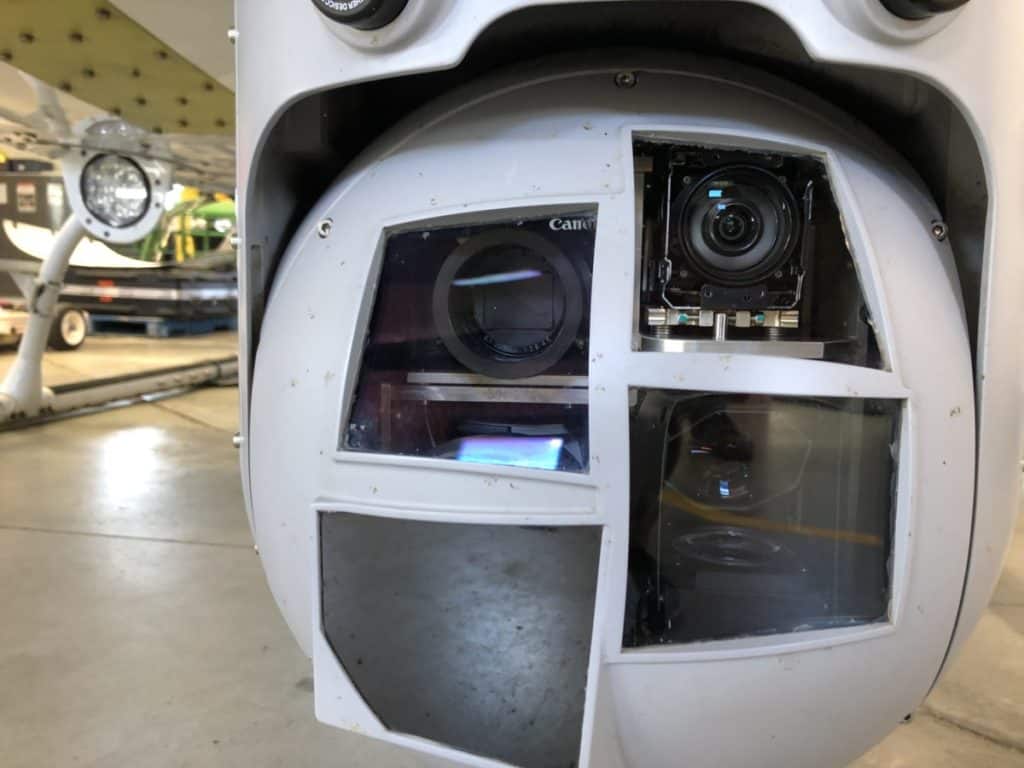
Just like your smartphone, the newer cameras have a much greater resolution that when paired with a powerful zoom lens can mean more detailed images even further away.
When searching for an object, the camera operator will slew the camera in the general direction and then begin to sweep the area using the camera as the helicopter is approaching. Once the object of interest has been found the detail of the image will begin to improve as the helicopter draws closer and the zoom is reduced.
Most police helicopters will set up an orbit within a 1nm radius to allow for the pilot to keep the area in view while the camera operator zooms in for the detail required for the mission.

Join My Newsletter & Get Great Tips, Information and Experiences To Help You Become a Superb Pilot!
Can Police Helicopters Detect Grow Ops?
Police helicopters can detect grow operations when heat lamps used to grow crops make the room, attic, basement, or building considerably warmer than their surroundings. This makes it easily seen by the infrared camera on the helicopter. Hidden plants grown outdoors can also be seen from the air.
Police cameras cannot see through solid objects like walls and roofs, but when a room is considerably warmer than its surroundings the camera operator can notice and refer the address to headquarters for further investigation.
The police helicopter can also see through windows during the day with its color HD camera, so if plants are on show and the police have the required permission to look through your window they can be seen. Police are not allowed to look into people’s windows with the camera unless they have permission or due cause.
Plants hidden and grown in the middle of other crops or densely wooded areas, they can be seen by an overflying helicopter. When visibly different from the surrounding foliage a grow operation can easily be seen by the persons onboard an overflying police helicopter.
For far more details on how police helicopters can detect Grow Operations see this article:
Can Police Helicopters Detect Grow Operations? Worried?!
Can Police Helicopters Catch You Speeding?
By using markers painted on the road or landmarks, police officers in a helicopter can time a vehicle between these markers. When the distance between the markers is known they can easily calculate the vehicle’s speed. By collecting video evidence they can then issue speeding tickets if required.
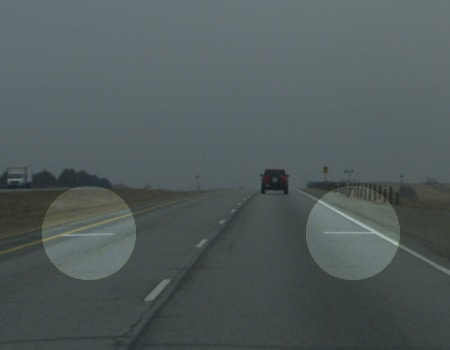
When used by a helicopter, the surveillance officer times between the two sets of markings using them is a visual reference, the same can also be done by an officer in a car following behind a vehicle of interest.
Lines painted at the side of the carriageway or squares painted in the middle of the lane can indicate that this is an area used by police for both airborne and land-based speed tracking.
If required by a court, the video evidence can be produced and shown as there is always a timer running on the video screen recording to ensure accurate evidence.
How Much Does a Police Helicopter Cost?
The average new police helicopter costs around $5-6M fully equipped. The cheapest start at around $1M and can go up to around $10M for the large, twin-engine, IFR-capable, multi-role helicopters. Smaller police departments can buy a used helicopter and have them equipped for the police role much cheaper.
Depending on the size and operating budget of the police department the addition of a new police helicopter can vary dramatically.
Small police departments can start with a Robinson R44 Police for just under $1M whereas their new Robinson R66 Police model will be around $1.4M. Other alternatives are to convert or buy a used police helicopter for much less. A used Bell 206 JetRanger could be picked up for around $500,000 or less depending on its age.
For police departments wishing to invest in the latest technology with two engines, for a multi-role mission-capable helicopter then the Airbus H135 and H145 are two of the most popular mid-range choices. These range between $5-8M depending on the aircraft and the equipment to be installed.
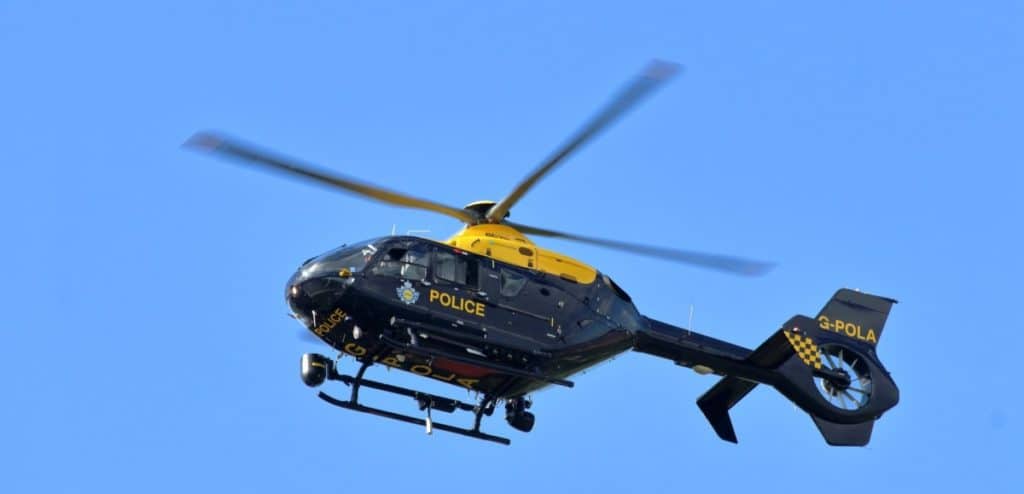
Winches, night-vision goggles, searchlights, auxiliary fuel tanks, and video & radio communications equipment have so many options and can soon add another $1M onto the purchase cost.
For police departments requiring large, multi-engine, all-weather, multi-role, troop insertion helicopters, then the Airbus H225 and Leonard AW139 are popular choices. These can begin around $10M and up and require serious investment and operating budgets.
Do Police Helicopters Fly at Night?
Police helicopters fly at night when the cloud ceiling is high enough and the forward visibility is clear enough. Most criminal activity occurs during the night and the cooler air allows the thermal imaging camera to detect heat sources more easily. Some pilots will also use night-vision goggles.
Police helicopters are equipped and their crews are trained to fly in all weather conditions, especially at night. In fact, many police departments may only run their helicopter/s during the night to save on operational budget.
Due to the majority of criminal activity happening during the evening, a police helicopter may be airborne over the city for the entire evening, just returning to base for fuel. If the helicopter is already airborne when it is requested, it only takes a matter of minutes to be overhead a scene within minutes – this becomes especially helpful in areas of high car crime.
Over densely populated cities, the light pollution given off allows the pilot to see almost as clearly as during the day. For locations that are a little more rural, most police pilots and crew will be equipped with night-vision goggles to allow them to see even in the darkest areas of their patrol boundary.
Do Police Helicopters Have Night Vision?
All police helicopters have infrared night vision cameras that enable the operator to see at night. On some helicopters, the crew also has night-vision-goggles to improve spatial awareness and allow for landings in dark areas to assist with MedEvac and crew insertion.
Night vision in a police helicopter can be split into two types:
- What the camera can see
- What the crew can see
In terms of the camera, it uses the infrared spectrum to detect heat from a source. Because objects absorb and radiate heat at different rates it allows the camera to identify objects in relation to one another. A cold building gives off far less heat than a person walking their dog alongside it.
The camera uses grayscale to differentiate the heat by dark objects showing as black and hot objects showing as white (The camera colors can be switched by the operator if required).
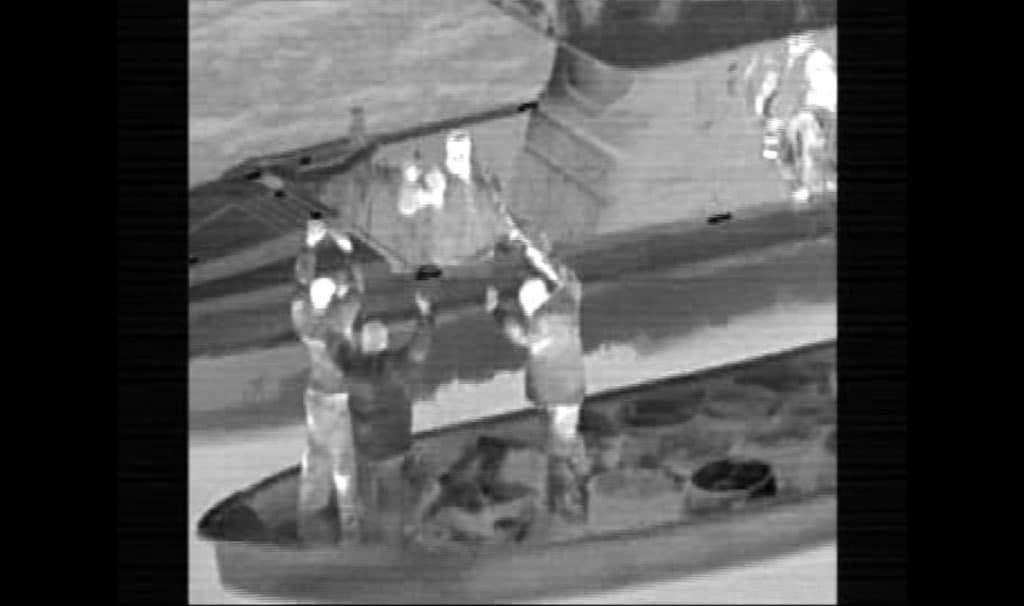
When hot objects are placed next to cold objects it is easy to identify them using the camera. This is why infrared cameras are so effective at tracking people and animals, especially at night when the surrounding air temperature is cooler.
In terms of the crew, it depends on each police department as to whether they equip the helicopter crew with night vision goggles (NVGs). For crews that fly over a large metropolitan area for the majority of their evening, the addition of NVGs is not required.
NVGs turn the blackest of nights into daylight and when worn by the pilot they allow the pilot to see much more. This becomes really useful when operating in remote parts of the country where there is no ambient light from a city. NVGs give the pilot greater freedom to fly the aircraft to assist with ground units or when inserting crews or landing in unlit areas.
NVGs allow the police helicopter to be used for a much wider variety of roles making it a more versatile asset to the police department. Having flown EMS at night I can tell you the NVGs are an absolute must when outside of a well-lit city!
If you wish to find out more about how pilots see at night please check out the following article:
How Do Pilots See At Night? A Pilot Tells All!
Can Police Helicopters Be Tracked?
All police helicopters are tracked by air traffic control but only some can be tracked by the public. Some police departments allow online tracking tools like FlightRadar24.com to track the helicopter to allow the general public to see where it is flying.
One of the most interesting online tracking tools FlightRadar24 tracks aircraft and displays it via your web browser. The system interrogates a device on the helicopter called a transponder. The information that it receives tells it where the helicopter is, it’s heading, its altitude, and its speed.
If the helicopter has been allowed to be tracked by the police department it’s just a case of clicking on the aircraft icon on the screen and reading its information:
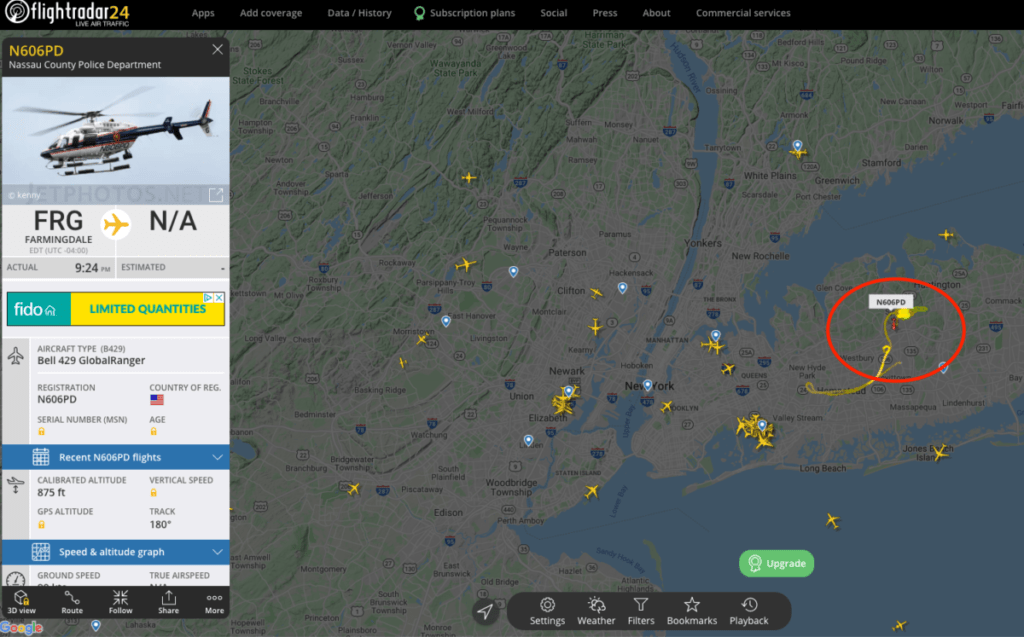
This screenshot from FlightRadar24.com tells me the Nassau County Police Helicopter is a Bell 429, flying at 875 feet, heading south and it shows me where it’s flown.
Take a look for yourself. Zoom in around the major cities and have a look for the helicopter icons then click on them. If your local police helicopter has been allowed to be tracked it will show up when it becomes airborne. At night is the best time to find them flying 😉
Do Police Helicopters Have Guns?
Police helicopters do not come equipped with guns. In North America, sworn-in police officers who form the crew are usually armed along with any specialist law enforcement team carried on board. The FAA does not allow civilian aircraft to be armed with weapons.
Police helicopters are mainly a transport and observation tool used by police departments. Most of the time they play a passive role in law enforcement and are there to watch and report from a distance. The need for weapons to be mounted to the helicopter is minimal and would never be able to be used effectively in today’s civilian world.
Sworn-in law enforcement officers are allowed to and do carry sidearms on their person, however, any civilian pilot is not allowed to carry (Unless in a state with legal carry firearms laws). If the need arises, the pilot can land to deploy the armed crew onboard if ground units are some time away, but this is very rare.
Do Police Helicopters Have Sirens?
Police helicopters do not come equipped with sirens but some can have a public address system. This allows the crew to issue verbal commands from the helicopter to persons on the ground. Some sound effects may be available to the crew to help get the attention on the ground, but these are rarely used.
A siren on a police helicopter would have no use as the sirens we are all familiar with on emergency vehicles are designed to get the attention of other road users to let them know the police require their personal attention or by means of getting people to move or be aware of an incident.
Police helicopters can be fitted with a system known as ‘SkyShout’ or similar. This is a public address system that allows crewmembers to talk from the helicopter using an attached loud hailer. As part of this system, there can be tones that are sounded to ensure the people on the ground are aware the helicopter is about to pass a message.
The system is mainly used to help disperse large crowds, to warn of imminent danger to the public or to help guide persons.
Further Reading
If you found this article helpful here are a few more I recommend:

